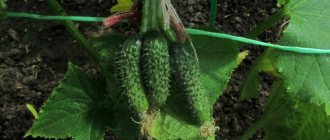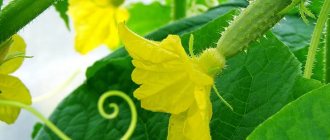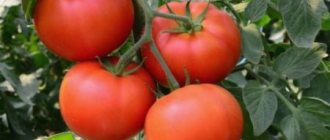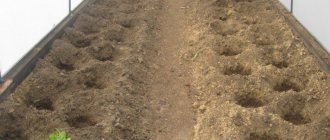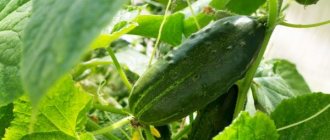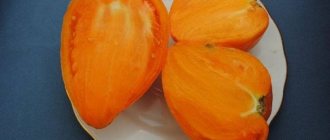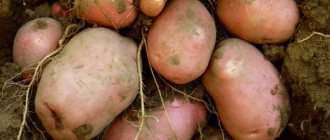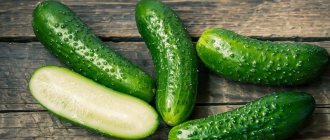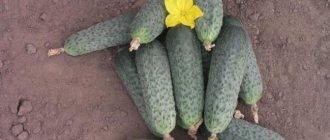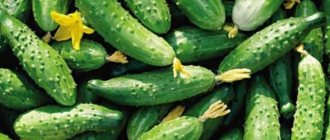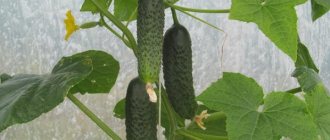Description of Zanachka cucumbers
Cucumber Zanachka f1 is a variety whose cultivation does not cause trouble and pleases with a large harvest. The variety was bred by a group of Russian agricultural breeders and is intended for open beds and removable temporary film or glass shelters.
The fruits ripen within 38-40 days after germination, so Zanachka is an ultra-early variety. Cucumbers are also characterized by their versatility in preparation: green varieties are suitable for all types of processing and for preparing fresh dishes.
Characteristics of the variety:
- Zanachka f1 bushes grow of medium length (up to 2 meters) and belong to abundantly branching plants;
- Description of flowering: the variety is characterized by mixed flowering with a predominance of female inflorescences painted in a rich yellow color;
- The foliage of the bushes is medium-sized, rich green in color, with a rough surface plate;
- Description of cucumbers: the fruits of the variety grow up to 13 cm and take on an oblong cylindrical shape;
- Cucumbers are characterized by a dark green peel with white stripes and pronounced tubercles, from which small white spines can be seen;
- Description of the pulp: cucumbers are characterized by juicy and dense pulp;
- Taste criteria: Stash f1 has a sweet, pleasant taste, devoid of bitterness.
Pros and cons of the variety
The breeders who developed the Zanachka variety note only the advantages of cultivating cucumbers. However, experience in cultivating the crop shows that the variety also has disadvantages. Below is a description of all the positive and negative characteristics of growing Zanachka cucumbers, which were bred by vegetable growers during the period of cultivation of the variety.
pros
- The variety has a high yield, since 1 m2 produces more than 10 kg of fruit;
- Cucumbers are characterized by excellent taste, which does not change even after preservation;
- Resistance of the variety to crop diseases;
- The f1 stash is famous for its versatility in using its fruits;
- Cucumbers are famous for their early ripening;
- Cucumber bushes are unpretentious in agrotechnical procedures;
- The variety is characterized by resistance to transportability;
- Excellent external qualities that allow you to grow cucumbers not only for your own use, but also for sale.
Minuses
- Lack of seed material in cucumbers;
- The hybrid variety Zanachka is not intended for cultivation in greenhouse conditions, since the plant requires pollination by insects.
Advantages and disadvantages
Gardeners have been growing the domestic hybrid Farmer F1 for more than fifteen years. New hybrids are appearing, but this cucumber remains popular. The variety has many advantages:
- high rates of fruit collection (including on open ground ridges;
- excellent taste characteristics;
- mid-ripening;
- resistance to sudden temperature changes;
- stable fruit yield;
- keeping quality;
- long fruiting period;
- excellent presentation of greens;
- resistance to a number of crop diseases.
Summer residents praise the cucumber, and farmers who grow the hybrid for sale are pleased with the yield indicators.
Disadvantages include:
- absence of parthenocarpy. To obtain high yields, it is necessary to take care of attracting bees and planting pollinators. In small areas, it is advisable to use hand pollination of bushes;
- impossibility of collecting seeds for subsequent crops. Hybrids labeled F1 do not retain parental characteristics in subsequent generations, so each season you have to buy new seed material.
There are not many disadvantages; the advantages of the variety outweigh.
Landing Features
To ensure that Zanachka bushes are not susceptible to diseases and develop well, vegetable growers recommend observing the planting characteristics of the variety. Below is a description of all the tips for planting cucumbers.
Landing dates
In the southern regions of the country, Zanachka f1 seeds are planted by sowing in late spring - early summer. In the cold regions of the Russian Federation, cucumbers are grown by seedlings. Cucumber seeds are planted for seedlings in the second half of April - the first half of May.
Site preparation
Before you begin preparing the site, you need to choose the right location for future beds. Cucumbers are suitable for sunny beds where cabbage or nightshade previously grew. After harvesting - in the fall - the soil is carefully dug up, dry tops and weeds are removed. Next, it is recommended to feed the cucumber beds with mineral components and leave them for the winter.
With the onset of warm weather, the soil is loosened and fed with potassium or phosphorus components.
Planting seedlings
To plant Zanachka f1 seeds for seedlings, use peat pots or plastic containers. Mixed soil from the garden with humus, peat and sand is poured into each vessel. Several cucumber seeds are planted in each container and placed in a warm place. The room temperature is set at 27 degrees and lighting up to 16 hours. After germination of Zanachka seedlings, the temperature is lowered to 20 degrees.
Cucumber seedlings are planted in a permanent location when 3-4 leaves form on the bushes and the soil temperature reaches 13-15 degrees. It is recommended to plant the bushes to a depth of 5 cm. Sprinkle the seedlings down to the lower leaves and water with warm, settled water. Next, it is recommended to cover the beds with film for several days.
Agricultural technology of the hybrid Zanachka F1
Despite the fact that bee-pollinated cucumbers require more attention, gardeners annually plant different varieties in beds and greenhouses. Such cucumbers have a number of advantages over parthenocarpics: they are tastier, more aromatic, so they do not lose their positions.
The crop is grown mainly through seedlings; only in the southern regions are the seeds sown directly into the ground. Sowing seedlings and then planting allows you to get early harvest of greens and extend the harvest period.
Sowing cucumbers for seedlings
“Sowing” for cucumbers begins at the end of April, but the exact timing depends on the climate of the area and the future location of planting. When cultivating in greenhouses, sow in the middle or end of April; when planting in beds in open ground, sow seedlings no earlier than the beginning of May.
Approximate timing of seed sowing:
- in the middle zone for heated greenhouses - from April 12-15;
- in the middle zone for planting on ridges - in early May;
- in the North-West, Siberia, and the Urals, seeds for seedlings are sown in early May.
Peat pots, plastic and paper cups are prepared for sowing. The volume of the containers is 0.5 liters so that the root system of plants can develop freely. Cucumbers are sown immediately in a separate container, since the crop does not easily tolerate diving. Sowing in peat pots is convenient: the root system of the seedlings is not damaged, the plants are planted in the ground directly in containers with nutrient soil. When planting from plastic cups, the transfer method is used, taking out the seedlings immediately with a lump of earth.
When preparing mixtures yourself, take:
- turf or leaf soil;
- humus (peat);
- coarse river sand, vermiculite.
When growing seedlings, the temperature regime is observed and the required level of lighting is maintained. Water moderately as the soil in the pots dries.
On a note!
It is convenient to irrigate seedlings using a spray bottle. At the same time, prevent moisture from getting on the plants; water only on the ground.
Feed as needed, since in well-fertilized soils plants grow quickly and do not need additional feeding. For slow growth, fertilizing with Agricola No. 5 seedling composition is recommended.
About a week before planting, the cucumbers are taken out into the fresh air. They begin to harden with 20-30 minutes, then the duration is gradually increased. Hardening promotes rapid adaptation of plants after planting and increases plant immunity.
Cucumber care
The basic techniques for caring for a bee-pollinated hybrid are standard:
- irrigation;
- fertilizing;
- prevention of diseases and pests;
- weeding;
- formation of bushes.
It is necessary to ensure complete pollination of the crop, otherwise the harvest will be small.
Recommendations for agricultural technology:
- Careful selection of place for culture. For cucumbers, select an area well illuminated by the sun, with slight partial shade.
- The ridges are prepared in the fall: plant debris is removed, the soil is dug up, and fertilizers are applied.
- To deoxidize the soil, dolomite flour, chalk, and fluff lime are added to the soil.
- Cucumbers are planted when the soil warms up to +14ºC…+15ºC.
- When planting seedlings in shelters, supports and trellises are arranged in advance.
On a note!
In garden beds, cucumbers are often grown spread out.
Agronomists recommend changing the location of the crop every year and alternating the planting of vegetables on the plot. A good result is obtained by sowing a cucumber bed in the fall with green manure: mustard, rye or winter oats. Before the cold weather, the plants are planted in the soil, creating a plot of fertile soil in the spring.
Bushes are planted 2-3 pieces per 1 m². When growing the hybrid Zanachka F1 in greenhouses, it is necessary to plant a pollinating cucumber with it. The planting pattern does not matter - it is important that plants with a large number of male flowers grow nearby in the same bed. Hybrids Bumblebee, Nectar, Casanova are popular.
Watering
Particular attention is paid to watering cucumbers. Demanding on air and soil humidity, plants need regular irrigation, but without excess moisture. Before flowering, water approximately 6-8 liters per 1 m². In shelters they water more often, in beds - taking into account rainfall. If clear days alternate with rainy ones, then the plants have enough moisture from precipitation and do not need additional watering.
After flowering and at the beginning of the fruiting stage, water abundantly, 4-6 liters for each plant. In shelters, humidity levels are controlled; they should not exceed 85%.
It is recommended to mulch between rows using mown grass, sawdust, and peat. Mulching prevents the soil from drying out and prevents the growth of weeds. The soil structure improves, a hard crust does not form, and caring for cucumbers is greatly simplified.
Fertilizing
During the growing season, cucumbers are fed 4-5 times. The crop is demanding in terms of nutrition, and productive hybrids produce high yields with frequent application of fertilizers.
At the beginning of the growing season, cucumbers need nitrogen, so organic matter is recommended (poultry droppings diluted 1:15, mullein 1:10). From the moment of flowering onwards, mainly potassium-phosphorus compounds are added: superphosphate, wood ash, potassium sulfate. It is convenient to use ready-made formulations that contain the nutritional components necessary for the culture:
- Agricola;
- Crystalon;
- Ideal.
Supporters of organic farming use an infusion of fermented nettle with wood ash, an infusion of ash, solutions of boric acid, and yeast for fertilizing. To protect cucumber plantings from diseases and pest attacks, the plants are treated with fungicides, greenhouses are regularly ventilated, and leaves and trimmed vines are removed.
Plant formation
The bee-pollinated hybrid is pruned according to the scheme, following the recommendations of the breeders. The lower tier of the plant is blinded (up to a height of 50 cm), removing leaves, ovaries, and stepsons.
Side lashes are pinched:
- 1-2 leaves and ovaries (up to 1 meter) are left on the central stem;
- over a meter - pinch 2 leaves and the same number of ovaries;
- over 1.5 m, 3 leaves and 3 ovaries are left.
As soon as the top reaches the trellis, it is wrapped around the wire, lowered down and after about 10-15 cm it is also pinched.
Pollination of cucumber
Parthenocarpic and bee-pollinated varieties should not be planted together in the same bed. Otherwise, when pollinated by bees, ugly greens may appear in parthenocarpics. Bees are attracted for pollination.
This is easier to do for cucumbers in the garden. In greenhouses, they open the windows and doors, and spray the plantings with a solution of honey and sugar. Planting honey plants next to greenhouses gives good results.
On cloudy days, when there are no insects, the bushes are pollinated by hand. Use a brush to carefully transfer pollen from male to female flowers. Male flowers appear and open earlier, female inflorescences a little later. Their difference is simple: the presence of the ovary on the stem after the flower in female inflorescences (thickening). In male flowers the stem is without thickening.
Care
The appearance, taste characteristics and quantity of Zanachka f1 greens are influenced by agrotechnical procedures: watering, fertilizing and hilling the soil, forming and tying up bushes of the variety. Vegetable growers offer recommendations for caring for cucumbers, a description of which is presented below.
Watering
Zanachka f1 bushes need regular watering. Cucumbers are usually watered with warm water in the evening. Since the cucumber root system is located close to the surface of the earth, the soil should not be allowed to dry out.
Watering work must be carried out once every 2-3 days. In dry weather, the number of watering procedures increases to daily. Also, when watering, you need to pay attention so that the liquid does not get on the tops of the plant.
After watering, it is recommended to loosen and hill up the soil. As a rule, these agrotechnical processes are carried out once every 10 days. The procedures allow you to eliminate the stagnant layer of soil that does not allow oxygen and moisture to pass to the roots of the plant. Hilling also contributes to the formation of new roots of the plant and strengthening the main root of the Zanachka bush.
Garter and bush formation
To prevent cucumber bushes from intertwining with each other and interfering with the development of their neighbors, it is recommended to tie the Zanachka f1 plant to vertical supports. To do this, the central stem is fixed to the trellis using a rope. It is also necessary to take into account that the stem is not overtightened.
Top dressing
Over the entire growing season, Zanachka cucumbers, like the Chinese Emperor variety, need 3 feedings.
Fertilize the soil with humus, cow manure, or bird droppings.
Vegetable growers note that mineral and organic components must be alternated. Fertilizing with only organic substances should not be allowed, since a large amount of nitrogen contained in manure and droppings leads to withering and death of the plant.
Diseases and parasites
The breeders who developed the hybrid variety Zanachka took care of the plant’s resistance to the most common crop infections. However, failure to comply with agrotechnical processes, or making mistakes during planting, leads to infection of the bushes with diseases such as nematode, ascochyta blight and white rot. We suggest considering a description of infections and methods of combating them.
Nematode
Nematode is a crop pest that sucks out all the plant juices of cucumber bushes, which contributes to the weakening, withering and death of the plant. The first sign of a nematode invasion on cucumbers is the wilting of the plant during the daytime. To prevent damage to bushes by nematodes, they are treated with Fitoverm, Carbofuran, Actofit and Marshall.
Ascochyta blight
Ascochyta blight is an infection that causes white spots to form on the stems of the plant, which become larger and affect the entire plant. The disease also manifests itself on the leaves of the bushes: the leaves become covered with gray spots, which over time acquire a brown tint, and the leaf itself begins to dry out. In addition, the infection also appears on cucumbers - they become wrinkled, covered with a whitish coating, and the fruit pulp takes on a gray tint. For ascochyta blight, the variety is treated with the substances Trichodermin, Trichophyte, Alirin-B, Fitosporin and Gamair.
White rot
White rot is a pathology that affects the entire plant: from the root system to the fruit. When a plant is infected with white rot, the bushes become covered with white spots that look like cotton wool. Also, mucous growths and white coatings form on the leaves, and the cucumber tops begin to wither and die. To prevent the disease, vegetable growers recommend treating cucumber bushes with chemical and biological preparations “Hom”, “Acrobat MC”, “Ordan”, “Topaz” or “Oxyx”.
general characteristics
Early ripening hybrid. The first fruits appear 36-40 days after germination of the seed material. When planting seeds in early May, the first fruits can be harvested by mid-June. The bushes are indeterminate, the length of the vines reaches two meters. Plants have medium foliage. The leaves are rich green in color, with a characteristic heart-shaped shape. The surface is rough to the touch. The ovary is formed in bunches. Female and male flowers are produced in equal proportions. The stems are powerful.
The greens are elongated, the tubercles on the skin are large, dark in color. The color of cucumbers is light green. The pulp is crispy, juicy, with a small number of seed chambers. The taste of greens is sweetish, with a distinctive refreshing aftertaste. The length of the fruit reaches 8-10 centimeters. The originator claims an average weight of 80-115 g. There is no bitterness in vegetables. Productivity on an industrial scale is 120-352 c/ha. Growing cucumbers at home, returns from 1 m² were recorded.
Advice! If plants affected by fungal diseases grew in the garden before planting cucumbers, the soil must be treated with a fungicide.
Advantages and disadvantages of the variety
Over the years of existence of the Serpentine variety, it has become the favorite of more than one gardener. Vegetable growers highlighted both advantages and disadvantages. The advantages include:
- short period of ripening of greens;
- universal use in cooking;
- unpretentiousness to growing conditions and climate;
- has resistance to the main range of diseases;
- high yields despite unfavorable weather conditions;
- plants tolerate morning frosts;
- drought-resistant;
- does not lose its presentation and taste for a long time. Excellent transportability over long distances.
The disadvantages of vegetable crops are:
- is susceptible to bacteriosis and powdery mildew;
- Seeds cannot be collected and replanted in the garden.
Treatment of plants for diseases
Resistance to diseases and pests
The Serpentine variety is susceptible to bacteriosis and powdery mildew. In order to prevent plants from getting sick, it is necessary to carry out constant care, carry out preventive spraying with folk remedies or preparations of biological origin. To treat plants, it is recommended to use:
- From bacteriosis. As a preventive measure, treat the seeds before planting with Phytolavin. Dissolve 2 ml of the substance in 1 liter of water at room temperature. Soak the planting material in the resulting solution for 1 hour. After that, plant the seeds in the garden or in pots for seedlings. For treatment, prepare a solution based on 20 ml of the drug and 10 liters of water. Phytolavine can be treated no more than twice per season.
Among the folk remedies for combating bacteriosis on cucumbers, there is a solution based on brilliant green and boric alcohol. To prepare the working mixture you will need: 10 liters of water at room temperature, 1 tsp. brilliant green and boric alcohol. Combine all the ingredients and spray the plants every 20 days until the symptoms of the disease completely disappear.
- Against powdery mildew. A simple garlic-based infusion will help against wilting of cucumbers. Take two small heads of the culture, chop them, add a liter of water at room temperature. Leave for 7 days. After that, strain the infusion, add 9 liters of water, stir. Spray the plants with the prepared solution. If the disease begins to progress rapidly, treat the vegetable crop with Fitosporin. Consumption rate: 10 liters of water will require 6-10 g. substances.
Advice! If you live in a region with a short summer, then plant cucumbers in seedlings.
Harvesting and storage
Since Zanachka f1 is a highly productive variety, it is recommended to harvest once every 2 days. It should be noted that cucumbers do not outgrow and do not lose their taste if the harvest is untimely. However, ripened fruits prevent the development of new cucumbers.
Zanachka gherkins are stored in rooms with a temperature of no more than 5 degrees Celsius. As a rule, basements such as cellars are used to store cucumbers.
